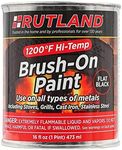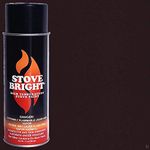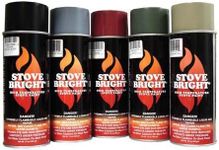Buying Guide for the Best High Heat Paint For Wood Stove
Choosing the right high-heat paint for your wood stove is crucial to ensure both safety and aesthetics. High-heat paint is specially formulated to withstand the extreme temperatures that wood stoves can reach, preventing peeling, blistering, or discoloration. When selecting the best high-heat paint, consider the following key specifications to ensure you get a product that meets your needs and performs well under high temperatures.Temperature RatingThe temperature rating of high-heat paint indicates the maximum temperature the paint can withstand without degrading. This is important because wood stoves can reach very high temperatures, and using paint with an insufficient temperature rating can lead to peeling or blistering. Temperature ratings typically range from 600°F to 2000°F. For wood stoves, a paint with a rating of at least 1200°F is recommended to ensure durability and safety. If your stove reaches higher temperatures, opt for a paint with a higher rating.
FinishThe finish of high-heat paint affects both the appearance and the performance of the paint. Common finishes include matte, satin, and gloss. Matte finishes are less reflective and can hide imperfections better, while gloss finishes are more reflective and can give a sleek, modern look. Satin finishes offer a balance between the two. Choose a finish based on your aesthetic preference and the look you want for your wood stove. Keep in mind that higher gloss finishes may show scratches and wear more easily.
Color OptionsHigh-heat paints come in a variety of colors, though the selection may be more limited compared to regular paints. The color you choose can complement your home decor and the style of your wood stove. Traditional colors like black, gray, and silver are popular for wood stoves, but some brands offer more vibrant options. Consider the overall look you want to achieve and how the color will fit with your existing decor.
Application MethodHigh-heat paint can be applied using different methods, including spray cans, brush-on, or roll-on. Spray cans are convenient and provide an even coat, making them ideal for intricate surfaces. Brush-on and roll-on paints offer more control and are better for larger, flat surfaces. Choose the application method that best suits your project and your comfort level with painting. If you are new to painting, a spray can might be the easiest option to achieve a smooth finish.
Drying TimeThe drying time of high-heat paint is the period it takes for the paint to dry and cure completely. This is important because the stove should not be used until the paint is fully cured to avoid any damage or fumes. Drying times can vary from a few hours to several days. If you need to use your stove soon after painting, look for a paint with a shorter drying time. However, always follow the manufacturer's instructions for the best results.
DurabilityDurability refers to how well the paint can withstand wear and tear over time, including exposure to high temperatures, cleaning, and general use. A durable high-heat paint will maintain its appearance and protective qualities longer, reducing the need for frequent touch-ups. Look for paints that are specifically formulated for high durability and have good reviews from other users. Consider your stove's usage frequency and choose a paint that can handle the level of use it will receive.



















